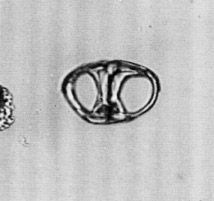 Liriospyris
stauropora (Haeckel)
Liriospyris
stauropora (Haeckel) Liriospyris
stauropora (Haeckel)
Liriospyris
stauropora (Haeckel)Trissocyclus stauroporus Haeckel, 1887, p.987. pl.83. fig.5
Liriospyris stauropora (Haeckel), Goll, 1968, p.1431, pl.175, figs.1-3, 7, text-fig.9; Riedel and Sanfilippo, 1971, p.1590-1591, pl.2C, figs.16-19
Sagittal ring subpolygonal; 39 to 85 µm high; 31 to 74 µm thick; joined directly to apex of lattice shell. No frontal or axial spines; vertical spine very short, broad, projecting from approximate midpoint of sagittal ring. Some specimens have short knoblike apical spine; in other skeletons, apical spine is lacking. A median furrow extends from vertical spine to front-apex of sagittal ring; in some individuals, furrow present on front of sagittal ring. Other specimens have vertical median ridge on front of sagittal ring. Eight basal connector bars joined to basal ring.
Basal ring oval; 46 to 102 µm wide; 22 to 42 µm thick; encloses four basal pores. No basal or lattice spines. Lattice shell oval in front view; 62 to 170 µm wide; not constricted sagittally; restricted to narrow lateral band that does not extend below basal ring. Lattice bars narrow; subcircular in cross section; frame subcircular lattice pores 8 to 65 µm in diameter. Two lattice bars joined to each side of basal ring, and two to apex of sagittal ring. In some specimens, shallow depressions are at junctions of lattice bars or lattice bars and basal ring. Frontal and sternal pores; three pairs of sagittal-lattice pores; no vertical pore. Approximately nine-tenths of width of lattice shell is occupied by two pairs of sagittal-lattice pores adjacent to front and back of basal ring (Goll, 1968).
The lateral part of the shell consists of a narrow, delicate ladderlike structure with a single row of pores (Riedel and Sanfilippo, 1978a).
The unnamed ancestor of L. stauropora has two pores (rather than one) across the width of the frontal ring throughout, and in particular where it joins the top of the sagittal ring. L. stauropora arises by reduction of the frontal ring to one pore in width. Another superficially similar species with two pores in the frontal ring on either side of the top of the sagittal ring is L. elevata Goll (1968, p.1426-1427, pl.175, figs.4-5, 8-9, text-fig.9; 1972, pl.68, figs.3-4). That species occurs later than the termination of the L. stauropora - L. parkerae lineage, and its evolutionary relationships are not yet clear (Sanfilippo et al., 1985).
Although the frontal ring characteristically has a single row of pores throughout its length, in occasional specimens it has two pores across its width where it joins the basal ring. Primary lateral bars may be complete, or reduced to short remnants. Apart from these variations, the form is constant. Height of the skeleton at the sagittal ring is 60-75 µm and the total width is 90-115 µm (Sanfilippo et al., 1985).
The distribution of this late early Miocene species is the same as that of L. parkerae. Its morphotypic first appearance lies within the Stichocorys wolffii Zone and it evolved into Liriospyris parkerae within the Calocycletta costata Zone.
L. stauropora evolved from an unnamed ancestor by reduction of the frontal ring to one pore width, and into L. parkerae by eventual loss of the pores of the frontal ring.